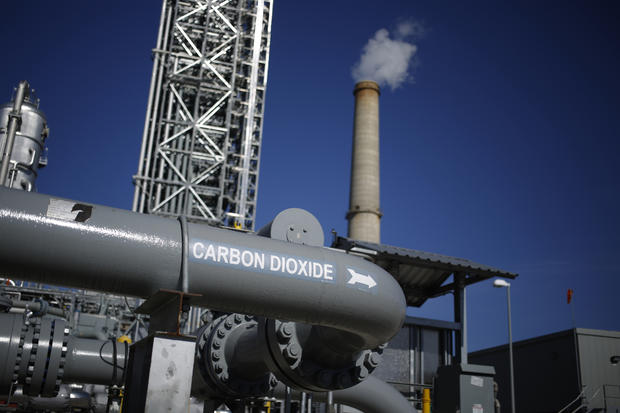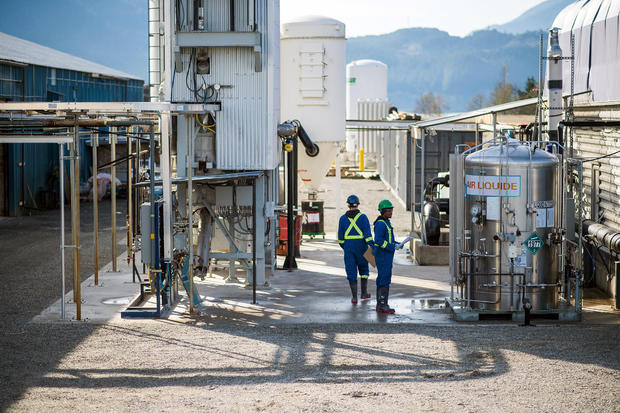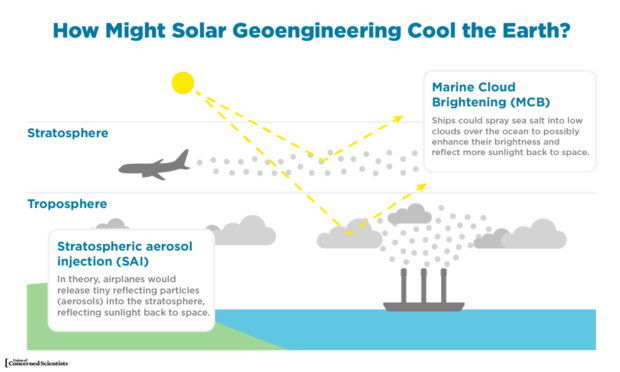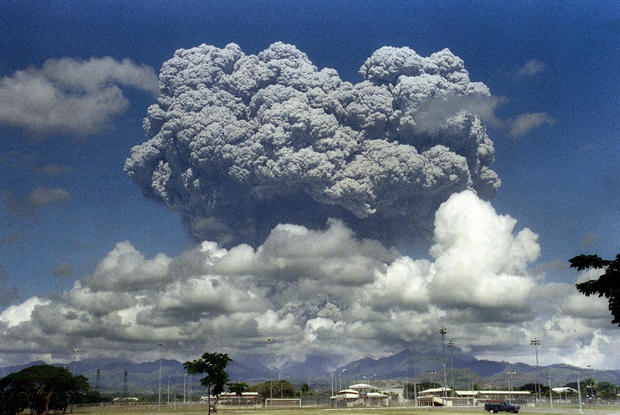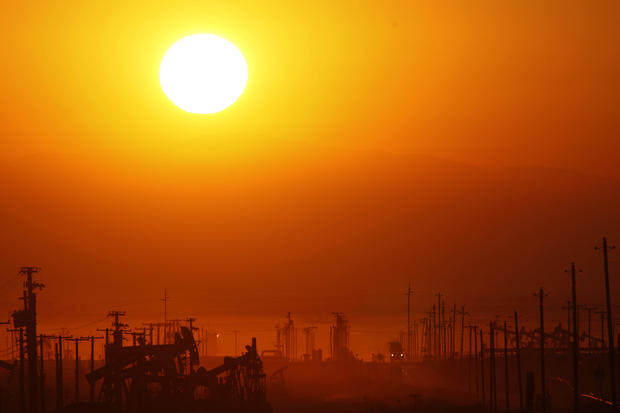▶ Watch Video: Geoengineering: A controversial solution that could help fight climate change
The climate crisis is arguably the biggest challenge humanity has ever faced, and to limit warming to manageable levels, time is our biggest opponent. While the transition from fossil fuels to cleaner renewable energy is now gaining steam, the pace is simply not fast enough to head off the harmful impacts that are already being felt throughout the world.
The Intergovernmental Panel on Climate Change (IPCC) “Special Report: Global Warming of 1.5ºC” — the international community’s benchmark guide to averting climate disaster — says to reach the goal of staying below 1.5ºC of warming requires “rapid and far-reaching transitions” in our energy, industrial and other systems that would be “unprecedented in scale.” In other words, the task is herculean.
So, many experts say drastic times call for drastic measures, arguing that technology like climate geoengineering should be part of the solution toolkit. Proponents say that while switching to renewable energy, driving electric vehicles and restoring forests can get us far, that’s simply not enough. The IPCC agrees, and cites one specific type of geoengineering — carbon capture and sequestration — as a necessary part of the suite of solutions.
While carbon capture — a process of trapping, compressing and then storing away harmful emissions to keep them out of the atmosphere — has its share of detractors, the climate community generally accepts that it will be necessary, though the extent to which it can and should be used is hotly debated.
But that debate pales in comparison to the controversy provoked by another proposed type of geoengineering known as Solar Radiation Management, in which humans would artificially dim the sun. That idea is loaded with compelling physical and ethical considerations which will be explored below.
Carbon capture
Since the Industrial Revolution, the burning of fossil fuels has released 1.6 trillion tons of heat-trapping greenhouse gases into the atmosphere. Carbon dioxide (CO2) has increased by 50% — at a pace 100 times faster than it naturally should. As a result, our planet is now warming 10 times faster than it has in 65 million years. The scale and speed is unprecedented.
Despite advances in clean energy like wind and solar, the world still gets 80% of its energy from fossil fuels. Because it is integrated into almost every nook and cranny of modern life, the challenge of eliminating carbon from our energy system is monumental. And even if humanity can significantly slow or even stop emitting carbon pollution, carbon dioxide will remain in the atmosphere for hundreds or even thousands of years. The only way to reduce greenhouse gas concentrations is to pull the carbon back out of the atmosphere.
In order to do that, there are natural solutions like forest restoration as well as technical solutions like carbon capture systems.
A 2017 research paper, led by the Nature Conservancy, found that natural climate solutions like restoring forests, wetlands and grasslands can, in a best-case scenario, provide 37% of the CO2 mitigation needed to keep humanity below the upper goal (2ºC of warming) of the Paris Agreement. That’s significant, but not enough.
Chad Frischmann, the senior director of research and technology at Project Drawdown, a climate solutions organization, prefers if society concentrates on developing ways to get nature to do the work.
“Overall, these natural forms of ‘carbon capture’ are tried, true and cost effective. More importantly, they have a ton of cascading benefits to agricultural productivity, biodiversity, and the health of the planet,” he said.
But carbon capture specialists like Dr. Julio Friedmann, a global energy policy expert from Columbia University — known as @CarbonWrangler on Twitter — believe technological solutions should have a bigger role to play because even if we shift to clean energy there are certain industrial processes, like cement and steel making, that cannot easily be decarbonized.
As is clear from his Twitter handle, Friedmann is bullish on carbon removal — not as a replacement for other solutions, but as a complement to them.
“CO2 removal is one mitigation strategy. It is a mitigation strategy like efficiency, renewables, electric vehicles. It is just one of the many things that we will do,” he said. “But if we do everything we know how to do today there’s always this fat residual 10 billion tons a year that we have no solutions for.”
Carbon capture — often referred to as CCUS, for carbon capture, utilization and storage — is an industrial process by which carbon dioxide is absorbed during power generation and industrial processes and stored away, typically underground, sometimes utilized for enhanced oil recovery or used in certain manufactured goods.
Globally, there are about 50 large-scale CCUS plants, including 10 currently operating in the U.S.
A less common but growing method is called direct air capture (DAC), in which carbon dioxide is sucked right out of the air through the use of large fans. There are currently only 15 DAC facilities worldwide which capture only 9,000 tons of carbon dioxide a year. Some larger facilities are planned. The Swiss company Climeworks is building a DAC plant in Iceland capable of capturing 4,000 tons, and the American petroleum giant Occidental plans a much more ambitious facility in the West Texas Permian Basin which it says will capture 1 million tons of CO2 a year.
Collectively all these CCUS and DAC facilities have the capacity to capture about 40 million tons of carbon dioxide yearly. It sounds like a lot, until you consider that each year humans emit almost 40 billion tons of carbon dioxide into the atmosphere —1,000 times more than we can capture — to say nothing about all the CO2 that is already up there as a result of the Industrial Revolution.
To put it bluntly, critics say CCUS and DAC are not ready for prime-time and may never be. The processes are very expensive, they consume copious amounts of energy themselves — often, ironically, produced by burning fossil fuels — and their capacity is just a tiny fraction of what’s needed.
Frischmann said, “They will never scale to the level necessary to offset fossil fuel emissions, and will take 20 years of 20% annual growth to even start making a dent in the atmosphere. Highly unlikely rate of growth.”
He’s also concerned about the moral hazard of promoting carbon capture as a solution, because he says these “false silver bullets” mean emitters can keep emitting with the promise that technology will suck up all their pollution. “Attention to them now allows fossil fuel companies, and their cronies, to continue business-as-usual with the promise of a Band-Aid that is not materializing anytime soon,” Frischmann said.
But Friedmann disagrees. He believes good policies can help carbon capture scale up quickly.
“It’s not a technology challenge, it’s a finance challenge,” he said. “It’s helpful to think about these things like solar in 2002. Solar electricity in 2002 was expensive, not mass produced. And then there was this set of policy and innovation pushes that really dropped the price and helped commercialization.”
He also feels that mopping up our mess is a moral responsibility.
“If you accept that we should remove CO2 from the air and oceans, it is essentially a way of addressing prior wrongs. It’s a way of the Global North announcing its intentions to clean up its mess and say we are going to do this so the Global South doesn’t have to.”
Peter Kalmus (@ClimateHuman), a NASA climate scientist, says he supports the concept of carbon capture and thinks we should keep researching it, but he is “extremely skeptical it will ever be possible or helpful.” He thinks it should not be included in planning until we know it can be done at scale.
Kalmus puts it colorfully: “I feel the IPCC stepped way out of bounds in normalizing it in greenhouse gas budgets and scenarios. They may as well have included genies, fairies, and pixies in their scenarios.”
Kalmus shares a concern with many others in the climate community that focusing on carbon capture will distract us from the real work of getting off fossil fuels.
He said, “The most compelling ‘con’ to me is that it will be used by politicians, decision-makers, and the public to reduce the urgency and delay timescales for addressing what is surely the greatest emergency facing humanity.”
But clearly the two arguments are not mutually exclusive: carbon capture can both be used as a delay tactic and also be a necessary part of the solution.
President Biden’s ambitious climate agenda aims to bolster the U.S. carbon capture capacity, not only to clean up the environment but also to create jobs. His $2 trillion infrastructure plan includes funding for carbon recapture plants. This is a rare area of agreement for Democrats and Republicans and may be a necessary inclusion to help garner support across the aisle. It’s even won support from the United Mine Workers of America, which backed incentives for using carbon capture technology along with measures to protect jobs in coal country.
Solar geoengineering
If the idea of artificially dimming the sun to minimize global warming seems like science fiction, you wouldn’t be alone in that opinion. It is certainly fraught with potential dangers and unknowns. But the concept is actually rather simple technologically, and relatively inexpensive. The challenges are not so much technical or financial, they are political and ethical.
Proponents like Bill Gates say solar geoengineering could buy humanity time to transition over to renewable energy. Opponents argue there are a multitude of concerns about the potential consequences.
Solar geoengineering proposals go by various names, including Solar Radiation Management (SRM) and Stratospheric Aerosol Intervention (SAI).
The idea is to fly specialized planes into the stratosphere, more than 50,000 feet above Earth’s surface, and unload small aerosol particles (like sulfates) which would block some of the sunlight from reaching the Earth. Because atmospheric winds are all connected, the suspended particles would circulate the globe. Less sun equals less heating. Theoretically, the amount of cooling could be controlled by managing the amount and distribution of aerosols the planes deliver. As long as the particles are up there, the cooling would continue.
There is also a less talked-about option called Marine Cloud Brightening. It’s somewhat similar in that particles are injected, but this time into clouds to make them brighter, whiter and more able to reflect sunlight back into space before it heats the Earth. Proposals suggest spraying sea salt aerosols from vessels into marine clouds. Those particles would act as condensation nuclei allowing more cloud droplets to form, blocking more sun. Here the impacts here would be more regional, not global.
Both types of solar geoengineering are explained below, in an illustration from the Union of Concerned Scientists.
Scientists know SAI could lower temperatures because a natural version of it is on display for all to see and measure when big volcanoes, like Mout Pinatubo in the Philippines, erupt and spew sulfates high up into the stratosphere.
In 2001, Pinatubo injected about 15 million tons of sulfur dioxide into the stratosphere, where it formed a hazy layer of aerosol particles composed primarily of sulfuric acid droplets. This blocked enough sunlight to reduce the planet’s temperature by 1ºF over the course of 1 to 2 years.
“The technical challenges for stratospheric aerosol geoengineering are not great, all that is needed is a new, high-altitude jet that could carry tons of material into the lower stratosphere, about 60,000 feet up,” explains Peter Irvine, a professor of solar geoengineering at University College London.
Specialized planes would be needed because the air is much thinner at that high altitude. Irvine believes it’s a cost-effective option to consider given the severity of the crisis facing the planet.
“Developing and running a fleet of such aircraft would cost a few billion dollars per year initially, which is small compared to the projected damages of climate change or to the costs of decarbonizing the economy,” he said.
A 2018 paper estimates the upfront cost for development of one such aircraft would be $2 to $3 billion, and maintaining a fleet of planes making 4,000 worldwide missions per year would cost around $2 to $2.5 billion per year over the first 15 years.
Frischmann says it’s the affordability that scares him.
“It is cheap, and this is scary. There are any number of billionaires, corporations or small states with the wealth to inject enough sulfate into the stratosphere to cause irreparable damage. Chilling thought,” he said.
The damage that might be caused by tampering with the atmosphere is debatable and unknown because there simply hasn’t been much real-world research done. That’s partly because any atmospheric modification, or even the consideration of it, is highly controversial.
A major concern among many climate scientists is the chance of unintended consequences from artificially cooling the Earth with aerosols. Could it cause floods in one nation and droughts in another? Will it weaken the ozone layer? Will it hurt species or ecosystems? Could it be used unilaterally as a weapon by one nation to inflict climate damage on another? Some of these hypotheticals may be more likely than others, but these are questions that can only be answered by research.
Its ability to raise alarm was on display a few weeks ago. A very small research project called SCoPEx, by a group of Harvard researchers, which was scheduled for this summer, was just postponed until at least 2022. To illustrate how divisive the concept is, the team wasn’t even spraying any aerosols — just testing equipment. Regardless, Swedish environmental organizations and the Indigenous Saami Council sent a letter demanding the project be canceled, calling the plan a real moral hazard and saying the technology entails risks of catastrophic consequences. The Harvard advisory committee put it on hold, pending further societal engagement.
While Irvine is bullish on SIA’s “potential to reduce the risks of climate change if used as a complement to emissions cuts,” he is quick to point out that a much better understanding is needed: “We don’t know enough about its potential, limits and risks to make recommendations on whether or not to deploy it. Research is needed to better understand its potential physical consequences, as well as to understand the broader social and political challenges it poses.”
In 2019, the U.S. government allotted $4 million for stratospheric monitoring and research efforts. The program includes assessments of solar climate interventions such as proposals to inject material into the stratosphere.
A year ago, Irvine and Dr. David Keith, another well-known expert in solar geoengineering, published a paper looking into the effectiveness and potential side effects of SAI. In a geoengineering model study, the team found that halving warming with stratospheric aerosol geoengineering could potentially reduce key climate hazards and would have limited regional side effects. But a limited model study is not nearly enough to base these monumental decisions on.
Recently, solar geoengineering supporters got a boost from a powerful scientific organization. Given the urgency of the risks posed by climate change, the National Academy of Sciences recommended that the U.S. government should cautiously pursue a research program for solar geoengineering, with funding in the $100 to $200 million range over 5 years.
But even if solar geoengineering worked to cool temperatures, it would do nothing for the problem of ocean acidification, because it does not address the root cause of the warming — the carbon dioxide which traps heat and dissolves in the ocean to make waters more acidic.
For all these reasons, many in the climate community believe the cons outweigh the potential pros.
“In short, do not try to fix a global, catastrophic problem with a Band-Aid that no one knows will work as intended, or knows what long-term unintended damage can be done to the planet,” said Frischmann.
Kalmus sees the value in researching solar geoengineering, but says the fact that we are even contemplating it evokes visions of a dystopian future. He goes further by discussing what is likely the most risky aspect of SAI.
“Solar geoengineering has an even darker aspect which is that the moment society stopped doing it, for whatever reason, there would be a rapid spike in global mean temperature, which is an extraordinarily dangerous prospect,” he said.
In other words, if the world used SAI to hold down temperatures for 30 years, and then stopped, almost immediately temperatures would spike the whole 30 years worth of warming in a year or two — with possibly devastating consequences for ecosystems and species that could not immediately adapt.
“It is a last resort lever to be pulled under the most dire circumstances for life on the planet. There is not a scenario where I see this as needed,” Frischmann urges. As an expert in solutions, he points instead to a more holistic set of changes we could make to energy use, industry, transportation, agriculture and other sectors that are supported by research.
Kalmus sees resorting to extreme geoengineering solutions as lazy and selfish.
“Saying either ‘we’ll figure out and do carbon capture later this century’ or ‘we’ll cool the planet with aerosols’ is negligently irresponsible, and basically says, ‘We old people can keep consuming and polluting, we’ll force our kids to pay the price.’ It’s intergenerational genocide.”
















